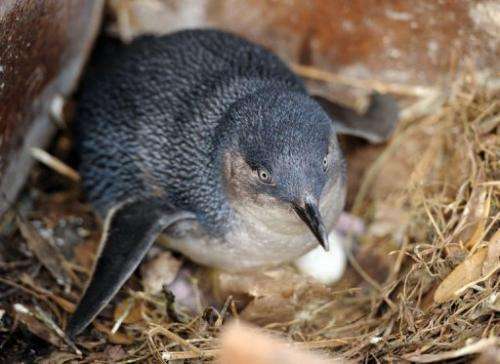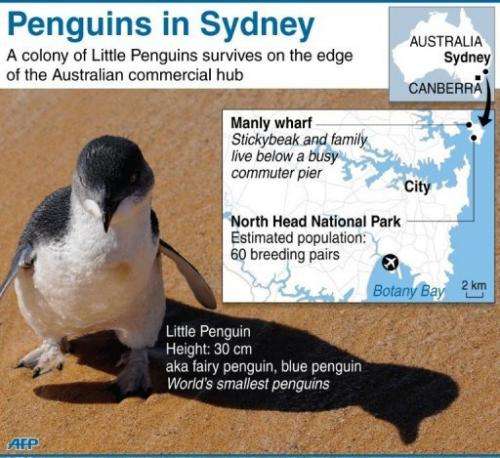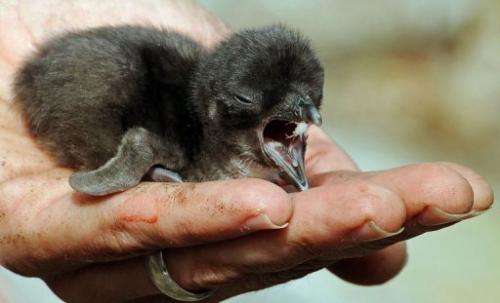Stickybeak and the penguins of Sydney

From the foaming wake of a Sydney ferry a small, grey figure sails towards the suburban Manly beachfront, landing belly-first on a closely-guarded strip of sand.
Stickybeak the penguin stands, shakes himself free of water and—after a furtive glance at the tourists gathered to watch his twilight return to the city's most famous bird nest—waddles off under the wharf to his brood.
"He's got a mansion under there," joked chief penguin warden Angelika Treichler, who stood guard behind a strip of safety cones and padlocked gates guaranteeing the bird free passage to his nest.
"He used to live next door, but now he's taken over the whole area."
Stickybeak, his partner Mrs Silverwing and their two chicks are the last remaining Little Penguins living under the Manly wharf, a bustling area for commuters and tourists.
Also known as fairy penguins or blue penguins the Little Penguin—the smallest species of their kind—grow to just 33 centimetres (13 inches) tall and can live for up to 20 years.
There are another 60 or so breeding pairs living in the nearby North Head National Park, a rugged wildlife preserve where Sydney Harbour meets the Pacific Ocean, but Stickybeak is a thoroughly metropolitan bird.
He joins hundreds of commuters taking the evening ferry from the city's bustling centre back to the beach, slipping into its wake to cruise home, and has been known to waddle over drunks passed out on his doorstep.

Treichler, a retired schoolteacher from Germany, has been watching him since volunteer patrols of the beach began when the colony was declared endangered in 2002 and has recorded his many adventures in the wardens' log book.
"He came up here once, up the steps, walked across the road and waddled into the Flamenco Club. Luckily one of the guests knew him, knew he lived here and put his jacket over him and carried him out," she told AFP.
"He used to sit for hours there on the boardwalk and sing very loudly, and look up whether we were listening, and when I would call him he'd come running out from under the wharf and cluck back at me."
Conservationists have worked hard to nurse penguin numbers back to health over the past decade, using sniffer dogs to hunt out foxes in the park and deploying wardens to educate locals about the dangers of dogs and garbage.
Ecologist Lisa O'Neill tags every penguin with a microchip once they're old enough to leave the nest, and says only 10 percent typically survive the transition to the harbour, with predators always lurking and speedboat strikes common.

There have been concerted efforts to move the penguins out of more urban areas—some nest under residential homes around the harbour—but success has been mixed with the deeply territorial creatures.
Stickybeak and Mrs Silverwing—his step-mother—were taken across to Store Beach in the national park in an attempt to resettle them after a stint in hospital but Treichler said they "came straight back here" to the wharf.
Their unorthodox romance blossomed in the rehabilitation unit of the city zoo, where Mrs Silverwing was mourning the death of her husband and Stickybeak was recovering from a boat strike accident that had killed his own partner.
They are the last of five pairs that once lived under the wharf, and Little Penguin coordinator with the National Parks and Wildlife Service, Melanie Tyas, said it was a double-edged sword.
"In some ways I think it'd be great if we had more penguins under here, but then on the other hand you've got that (factor of)—well it's one or two, it's so rare that it's such a special experience to see them," she said.
The birds hunt the length and breadth of Sydney Harbour, foraging for fish, squid and other marine animals, and O'Neill said it was rare to find a penguin colony on the mainland, let alone one in an urban area.
"It's just spectacular, it's an amazing privilege to have the birds so close to an area like this," she said.
"It's a wonderful thing to have so close to the city, we're really lucky."
(c) 2012 AFP



















